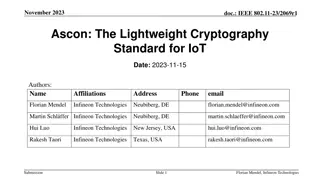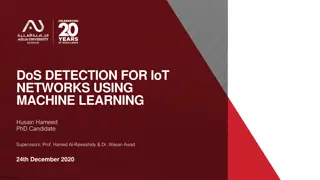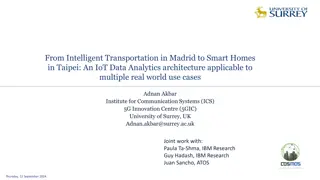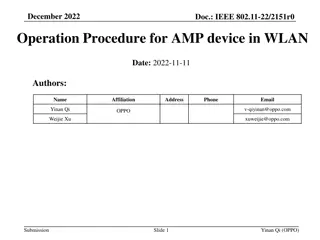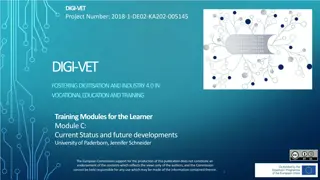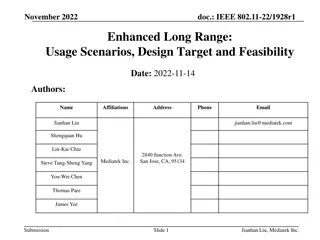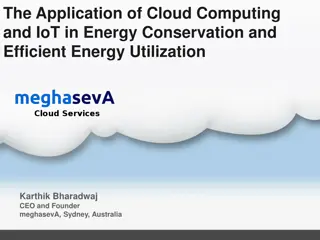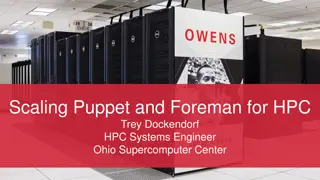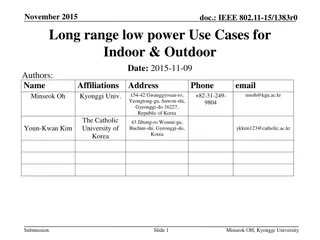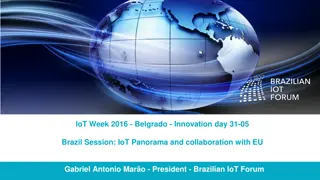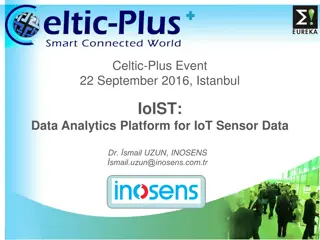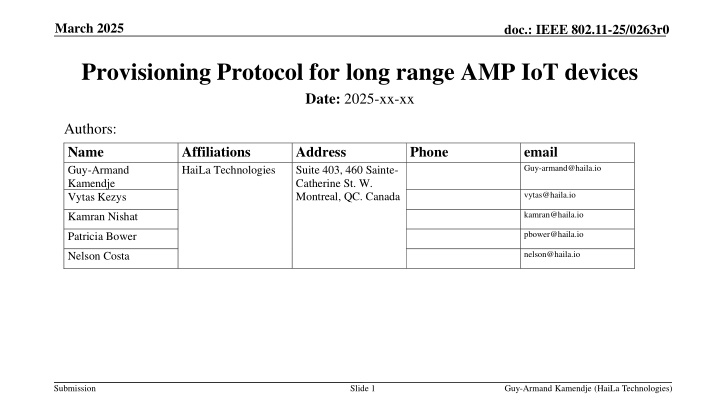
AMP IoT Device Provisioning Protocol for Long Range Connectivity
"Explore the IEEE 802.11-25/0263r0 protocol for provisioning AMP IoT devices, focusing on establishing trusted relationships, authentication, and security measures. Learn about the unique challenges and requirements for long-range backscatter technology. Discover the essential assumptions and constraints for successful device onboarding and provisioning."
Download Presentation

Please find below an Image/Link to download the presentation.
The content on the website is provided AS IS for your information and personal use only. It may not be sold, licensed, or shared on other websites without obtaining consent from the author. If you encounter any issues during the download, it is possible that the publisher has removed the file from their server.
You are allowed to download the files provided on this website for personal or commercial use, subject to the condition that they are used lawfully. All files are the property of their respective owners.
The content on the website is provided AS IS for your information and personal use only. It may not be sold, licensed, or shared on other websites without obtaining consent from the author.
E N D
Presentation Transcript
March 2025 doc.: IEEE 802.11-25/0263r0 Provisioning Protocol for long range AMP IoT devices Date: 2025-xx-xx Authors: Name Guy-Armand Kamendje Vytas Kezys Affiliations HaiLa Technologies Address Suite 403, 460 Sainte- Catherine St. W. Montreal, QC. Canada Phone email Guy-armand@haila.io vytas@haila.io kamran@haila.io Kamran Nishat pbower@haila.io Patricia Bower nelson@haila.io Nelson Costa Submission Slide 1 Guy-Armand Kamendje (HaiLa Technologies)
March 2025 doc.: IEEE 802.11-25/0263r0 Abstract An AMP IoT device provisioning protocol that can achieve the following is required: Establish a trusted relationship between the AMP IoT device and the infrastructure Compatible with both long range backscatter and active transmission devices Establish authentication (mutual), achieve confidentiality and integrity. Configure the AMP IoT device with a local address which is significantly shorter than the IoT device s secret identity Submission Slide 2 Guy-Armand Kamendje (HaiLa Technologies)
March 2025 doc.: IEEE 802.11-25/0263r0 Background Long range backscatter offer a different set of opportunities to close range backscatter (different use cases : i.e. smart manufacturing/power grid => characteristics and security requirements are different). While onboarding, vetting of AMP devices being added to the network is required. Onboarding should be highly automated End-to-end security protection is required for services involving AMP non- AP STA. Security should be enforced very early during device onboarding . Asymmetric channel with very limited DL Submission Slide 3 Guy-Armand Kamendje (HaiLa Technologies)
January 2025 doc.: IEEE 802.11-25/0263r0 Constraints Minimize the number of downlink messages (from the infrastructure to the AMP non-AP STA. AMP non-AP STA should not blindly trust an infrastructure that claims possession of its public key: additional proof of knowledge of non-AP STA s secret identity is required. Should be AMP non-AP STA s uplink mode of operation agnostic Should not use digital certificates AMP non-AP STA reprovisioning should be possible Submission Slide 4 Guy-Armand Kamendje (HaiLa Technologies)
March 2025 doc.: IEEE 802.11-25/0263r0 Fundamental assumptions 1. The AMP non-AP STA interacts with the Infrastructure through a Gateway 2. The AMP non-AP STA might non posses a MAC address in the 802.11 sense 3. The RX and TX function of the Infrastructure might be collocated on the Gateway 4. An Authentication Server (AS) might be used (Radius) The AS and Gateway might be collocated. 5. When not collocated, AS and Gateway can establish a trusted communication channel between them. The AS uses two distinct keys for communication with the GW and the AMP non-AP STA. 6. When not collocated, AS and Gateway can establish a trusted communication channel between them. 7. The AMP non-AP STA s Serial Number & Public Key record are located on the AS. Proof of ownership of these establishes the non-AP STA trust to the AS. 8. The AMP non-AP STA s Serial Number & Public Key record update mechanism on the AS is out of the context of this proposal 9. The Gateway sends a broadcast message to AMP non-AP STA devices to initiate provisioning 10. Proof of possession of the AMP non-AP STA s Public Key by the Gateway establishes the AMP non-AP STA trust in the Gateway Slide 5 Submission Guy-Armand Kamendje (HaiLa Technologies)
March 2025 doc.: IEEE 802.11-25/0263r0 Proposal: AMP non-AP STA provisioning mechanism and address allocation (bootstrapping) Gateway The AMP is in provisioning mode and stays in this mode until it has received its local address Provisioning is initiated by scanning a QR code using and APP on a smartphone 2 Gateway has trusted connection to AS APP Hash(A_pubk) 1 After manufacturing AMP device, A contains: A_pubk, A_privk, A_SN and AS_pubk AMP device in Provisioning Mode Submission Slide 6 Guy-Armand Kamendje (HaiLa Technologies)
March 2025 doc.: IEEE 802.11-25/0263r0 Proposal: AMP non-AP STA provisioning mechanism and address allocation Submission Slide 7 Guy-Armand Kamendje (HaiLa Technologies)
March 2025 doc.: IEEE 802.11-25/0263r0 Proposal: AMP non-AP STA provisioning mechanism and address allocation (temporal key derivation) A = TAG_SN || AS_pubk PRK = HKDF-Extract(<>, A) Tk1 = HKDF-Expand(PRK,GWID||TK_NONCE||LOCAL_ADDR|| TK1 ,16) Tk2 = HKDF-Expand(PRK,GWID||TK_NONCE||LOCAL_ADDR|| TK2 ,16) Both AS and AMP device can derive the Tks Tks are send by the AS to the GW No need to send the Tks to the AMP device Submission Slide 8 Guy-Armand Kamendje (HaiLa Technologies)
March 2025 doc.: IEEE 802.11-25/0263r0 Proposal: AMP non-AP STA provisioning mechanism and address allocation (session keys derivation) PRK TK1 TK2 Ek1i EK2i Cntr==i Cntr==i Ekxi = HKDF-Expand(TKx, CNTR ,16) GW instructs the tag which Tkx to use Counters start at zero and Re-key command advance the counter The Ekxi keys have a very short lifetime (determined by the GW) Ekxi can be used as a seed for the next PRK Submission Slide 9 Guy-Armand Kamendje (HaiLa Technologies)
March 2025 doc.: IEEE 802.11-25/0263r0 Proposal: AMP non-AP STA provisioning mechanism and address allocation (data protection) Gateway Gateway RES_SENSOR_DATA() Protected by EKi 0x234 REQ_SENSOR_DATA(ABCD) Protected by EKi 0x234 AMP device in Normal Mode AMP device in Normal Mode Submission Slide 10 Guy-Armand Kamendje (HaiLa Technologies)
January 2025 doc.: IEEE 802.11-25/0263r0 Conclusion A provisioning protocol that uses only one DL message from the infrastructure to the AMP IoT device was presented The presented provisioning protocol allows AMP non-AP STA local address allocation The presented provisioning protocol allows mutual authentication between the AMP non-AP STA and the infrastructure. The presented provisioning protocol allows symmetric key establishment Submission Slide 11 Guy-Armand Kamendje (HaiLa Technologies)
March 2025 doc.: IEEE 802.11-25/0263r0 Straw Polls SP1: Do you agree that the AMP non-AP STA could be allocated a local/short address? Submission Slide 12 Guy-Armand Kamendje (HaiLa Technologies)
March 2025 doc.: IEEE 802.11-25/0263r0 Straw Polls SP2: Do you agree that the AMP non-AP STA could be allocated a local/short address with a maximum of 2 downlink transactions? Submission Slide 13 Guy-Armand Kamendje (HaiLa Technologies)
March 2025 doc.: IEEE 802.11-25/0263r0 Straw Polls SP3: Do you agree that the AMP non-AP STA should establish a secured relationship with a Gateway/ Authentication Server. Submission Slide 14 Guy-Armand Kamendje (HaiLa Technologies)
March 2025 doc.: IEEE 802.11-25/0263r0 References Submission Slide 15 Guy-Armand Kamendje (HaiLa Technologies)

